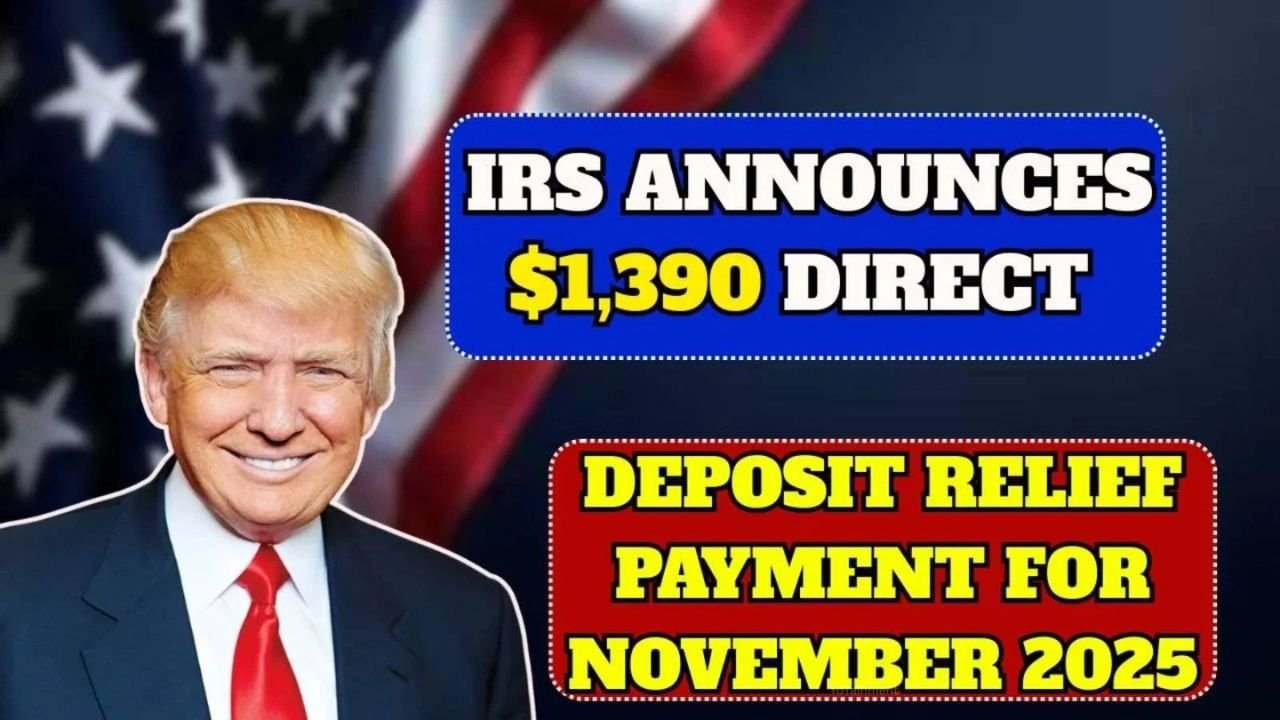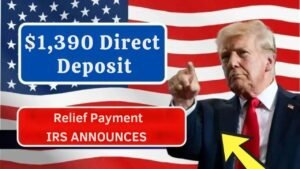Millions of Americans are finally set to receive meaningful financial support through the IRS $1,390 Direct Deposit Relief Payment, officially scheduled for November 2025. With rising rent, expensive groceries, and increasing fuel and healthcare costs, this relief payment comes at a crucial time for households battling persistent inflation. For many, the $1,390 payment is not just financial assistance—it is timely support during one of the most challenging economic periods in recent years.
What Is the IRS $1,390 Relief Payment?
The IRS, widely known for tax collection, also manages various federal relief programs. The $1,390 Direct Deposit is a special financial assistance measure designed to ease economic pressure on qualified Americans.
This payment is different from typical tax refunds or credits. Instead, it functions as a one-time inflation relief benefit, automatically delivered to eligible individuals through direct deposit starting in November 2025. The goal is to support working families, seniors, Social Security beneficiaries, and low-income households who continue to struggle post-pandemic.
Why the IRS Introduced the $1,390 Payment
The IRS launched this relief initiative to counter the rising cost of living affecting millions nationwide. Prices on essentials—such as housing, utilities, groceries, and transportation—have surged, straining household budgets.
The $1,390 payment aims to:
- Offset everyday expenses
- Assist families in maintaining financial stability
- Reduce inflation-related stress
- Boost spending to support the U.S. economy
By depositing funds directly into bank accounts, the government ensures quick, secure, and error-free delivery.
Who Qualifies for the $1,390 Direct Deposit?
The IRS has outlined broad but specific criteria to ensure the payment reaches the most vulnerable groups.
Eligibility Requirements
You may qualify if:
- You have a valid Social Security Number
- Your income is below IRS-defined limits
- You file annual income tax returns
- You receive Social Security, SSI, SSDI, or VA benefits
- You are a low-income worker, senior citizen, or person with disabilities
Seniors and disability beneficiaries will likely receive the payment automatically because the IRS already has their updated personal and financial details.
How the IRS Will Distribute the Payment
The distribution system is designed to be fast, reliable, and secure.
Payment Methods
- Direct deposit (primary method)
- Paper checks (for individuals without banking details on file)
- Prepaid debit cards (for those without bank access)
Most recipients will receive the payment without taking any action, provided their information is current.
Expected Payment Dates for November 2025
IRS officials have confirmed a phased rollout during the first half of November.
Estimated Timeline
- Week 1–2: Direct deposits for individuals with bank details on file
- Week 3: Mailed paper checks
- Week 4: Prepaid debit card distribution
This staggered approach ensures smooth processing and reduces system overload.
Why This Payment Matters for the U.S. Economy
Economists predict that the $1,390 relief payment will positively impact the economy by increasing household purchasing power.
Key Areas Positively Affected
- Grocery and retail spending
- Rent, utility, and housing costs
- Fuel and transportation expenses
- Healthcare and medication needs
For millions, the payment will help reduce financial stress while supporting local businesses and encouraging economic activity.
How Seniors and Low-Income Families Benefit
Older adults often rely on fixed incomes that don’t rise with inflation. Low-income workers face constant financial pressure as costs increase. The $1,390 payment can help these groups:
- Pay essential bills
- Cover medical costs
- Purchase groceries
- Manage emergency expenses
The relief provides both short-term stability and long-term confidence.
IRS Guidelines to Avoid Delays
To receive the payment on time, taxpayers should:
- File tax returns promptly
- Ensure bank details and personal information are updated
- Avoid unofficial websites and scams
- Check IRS updates regularly
Is the $1,390 Payment Taxable?
No. The IRS confirmed that the relief payment is not taxable, and recipients will receive the full amount without deductions.
What to Do If You Don’t Receive the Payment
If you qualify but do not receive the payment by the end of November:
- Check your payment status via the official IRS portal
- Review updated bank or mailing information
- Correct any mismatches to have the payment reissued
FAQs
1. Who is eligible for the $1,390 IRS payment?
Anyone meeting income limits, having a valid SSN, and filing tax returns. Seniors, SSI, SSDI, and VA beneficiaries also qualify.
2. When will the payments be sent out?
Direct deposits begin in early November 2025, followed by checks and debit cards later in the month.
3. Is the $1,390 relief payment taxable?
No. It is completely tax-free.
4. Do I have to apply for this payment?
No application is required. Payments are automatic.
5. What if my bank details are outdated?
Update them through official IRS channels to avoid delays.
Conclusion
The IRS $1,390 Direct Deposit Relief Payment offers essential support during a period of economic strain. With automatic deposits, clear eligibility, and a scheduled November rollout, this relief provides hope and stability for millions of Americans. Staying informed and ensuring your personal information is accurate will help guarantee timely payment delivery.





